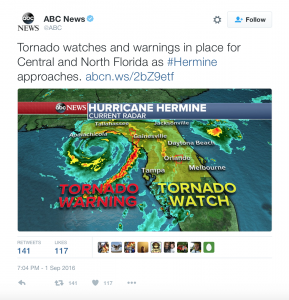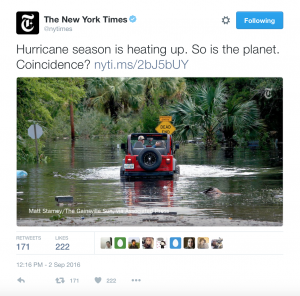By DANIEL LLOVERAS
When Hermine, the first hurricane to make landfall in Florida since Wilma in 2005, swept across the southeastern United States last week, news organizations were quick to pounce on the story.
Journalists from all over the country were sent down to Florida to capture the classic hurricane images: waves crashing on coasts, heavy winds blowing palm trees and citizens kayaking through flooded streets.
While the dramatization of hurricanes is nothing new and is usually harmless, journalists must be careful not to misinform the public with exaggerated depictions of severe weather events.

ABC News tweeted a radar image just before Hermine made landfall last Thursday night showing tornado watches and warnings throughout Florida.
The graphic, albeit dramatic, is unclear and makes the viewer think that almost the entire state and the Gulf of Mexico is under siege by tornadoes.
This kind of fear-mongering journalism is unacceptable, especially for a national news organization as reputable as ABC.
ABC is not the only national news outlet that posted a click-bait tweet during a time of crisis. The New York Times tweeted an article just a few hours after Hermine made landfall stating that the increased frequency of hurricanes this season could be related to global warming.
While sea-level rise due to climate change makes coastal areas more vulnerable to storm surge flooding, scientific studies have not shown any correlation between climate change and the frequency and intensity of tropical cyclones.
The New York Times could have waited until after Hermine dissipated to post the article, but instead decided to take advantage of some of the public’s worst fears in order to gain readers.
The purpose of news organizations during states of emergency is to calmly inform people of mortal danger based on scientific fact, not frighten the public with melodramatic stories and images.
